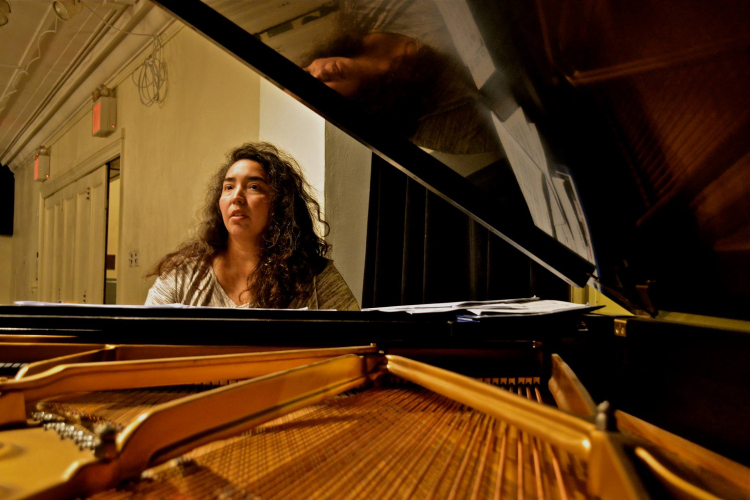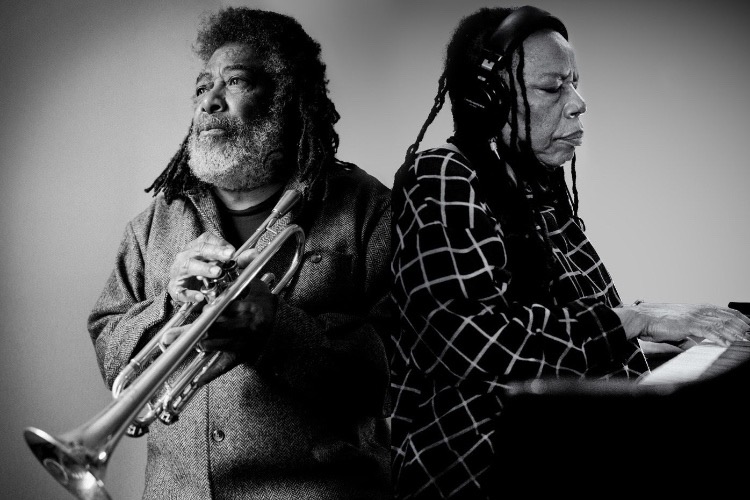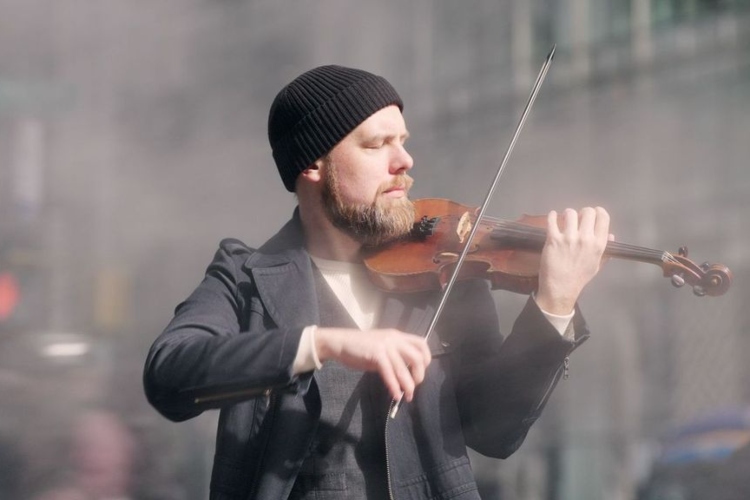Time is Fluid: A Conversation with Angelica Sanchez
|
Getting your Trinity Audio player ready...
|
Nathaniel Hawthorne once famously noted that “Time flies over us, but leaves its shadow behind.” While we all generally seem to understand an hour or a day, in a broader sense, what is time? Is it a static constant or a mere perception? Even Merriam-Webster’s definition of the term as “the measured or measurable period during which an action, process, or condition exists or continues” raises more questions than it answers. Those turning to the Angelica Sanchez Trio’s Sparkle Beings (Sunnyside, 2022) for clarity are unlikely to find it. Instead, they will discover an album that raises new grounds for inquiry.
Sanchez is an artist often unconfined by not only the thoughts of those who came before but even the limits of her instrument of choice. While her acclaimed debut record, A Little House (Clean Feed, 2011), found the pianist exploring some works of other composers – Ornette Coleman and Hank Thompson – she has generally shied away from releasing, under her own name, recordings of other artists’ works. Even on that album, her unconventional use of phrasing and, at times, adoption of a toy piano, stretched the pieces from their historical moorings. More common in Sanchez’s discography have been her own compositions or collaborations with artists who emphasize their own writings. One great example is her pairing with Marilyn Crispell, How to Turn the Moon (Pyroclastic, 2020), where the percussive elements of the piano are often given prominence as the two pluck and strike at their instruments’ strings.
With this backdrop, Sparkle Beings, at first blush, seems like a step backward. Around half of the album explores pieces by pianists past – Mary Lou Williams, Duke Ellington, Mario Ruiz Armengol, and Cecil Taylor. But a closer look confirms these historical antecedents are necessary to understand the expansiveness of Sanchez’s own pen, as further elucidated by the original pieces on the record. One should first note that while her artists of choice are fairly well-known names in some circles, Sanchez purposely eschews their most popular works. One will not find “Mood Indigo” or even “Roll Em” but deeper cuts from the ancestors’ oeuvre. The decision to select the lesser-known as some of her favorites is a testament to the pianist’s individualistic approach to music.
Sparkle Beings is an album that represents what standards should be; not grounds for continued repetition but launchpads for further artistic expeditions. While no one needs a millionth version of “‘Round Midnight,” it does not mean Monk’s entire songbook should be thrown out the window. History guides where we are, but it should be a path into the wilderness of exploration, not a freeway to another destination. The fact Sparkle Beings was recorded at the iconic Van Gelder Studios yet sounds wholly distinct from the Blue Note and other records captured at the venue further underscores this point. As does the inclusion in the trio of drummer Billy Hart – a master of rhythmic time – and how the result is distinguishable from other records throughout his career. We sat down with Sanchez to discuss the trio and broader concepts of time and neuroscience.
PostGenre: There are not many examples of you recording other composers’ works before Sparkle Beings. What inspired you to record other people’s compositions for the album?
Angelica Sanchez: Right. Though I will play other composers’ works in live performances, I don’t usually record other people’s compositions. But I felt a very strong connection to the three primary composers whose works are featured on this record: Mary Lou Williams, Duke Ellington, and Cecil Taylor. I’ve been living with the music of those three artists for so many years now that their music feels like a part of me. Every time I hear their music, it feels like coming home. All three are also connected musically. Mary Lou influenced Duke Ellington, and Duke influenced Cecil Taylor. They share a common language. I feel like my music is a further extension of those ideas. Ideas do not come from nothing and I have a significant connection to their music.
PG: And the fourth composer, Mario Ruiz Armengol, is connected to that common language as well.
AS: Definitely. Ellington studied with Armengol. I found his piece for this album, “Preludio a un Preludio”, from a little book of Armengol’s piano compositions and was very attracted to the tune.
PG: When selecting songs by these composers, did you know from the beginning which specific compositions you wanted to use, or did you pick the artists first and then hone in on specific compositions later?
AS: I selected the specific songs because they are some of my favorites. I had been listening to them for years, so they were already in my head. I especially love the Duke Ellington piece [ed. “The Sleeping Lady and the Giant Who Watches Over Her”, originally released as part of Ellington’s Latin American Suite (Fantasy, 1972)]. When I play it in concert, people in the audience often struggle to identify the piece. The song sounds so modern because Ellington was a very forward-thinking artist, and very far ahead of his time.
PG: Cecil Taylor was, of course, very forward-thinking as well. His “With (Exit)” was first recorded with a sextet on Conquistador! (Blue Note, 1968). Was it difficult to translate the song for a group with half as many musicians?
AS: No. I just chose what to include in the piece that would still allow it to hold the essence of the piece, even without horn parts. Some people have said that there are certain things you should not mess with musically, like a Duke Ellington composition. And not many people record Cecil Taylor tunes, for obvious reasons.
PG: Because Taylor had such an idiosyncratic voice.
AS: Right. But I think artists are supposed to “mess” with the music by the greats, especially those pushing forward musically, like Ellington and Cecil. They would play with existing forms so often, to both expand the tradition and explore.
PG: Related to the importance of tradition, Sparkle Beings is the first album you have recorded at the Van Gelder Studio. Were you in awe knowing that you were approaching “With (Exit)” in a place where Taylor first recorded the piece over fifty years earlier?
AS: I mean, the space has a special vibe. It was an honor to be in that space, with all the past lives who had gone through the studio. I had never been to the studio before we recorded there. Recording there was a beautiful experience. The walls hold so much history, including that of my heroes like Cecil and Herbie Hancock. I love how little the studio has changed over the years. New York has changed so much over the years and, at times, lost its charm. Van Gelder Studio [in Englewood Cliffs, New Jersey] wonderfully keeps things intact and continues to make music that retains that balanced, natural, and warm sound it is so well known for and that I greatly wanted for this record.
PG: Another thing that makes Sparkle Beings stand out from your other albums is that it is the first time you have recorded with Billy Hart. You first met Hart back in the 1990s. What took so long for you to record with him?
AS: Well, that is what Billy asked me [laughing]. I think I was scared to call him for a while just because he has always been one of my favorite artists. I always assumed he would be too busy to work with me, so I did not ask for many years. But I am very glad I finally asked him. It’s funny though because when we sit down to play together, it feels like we have been doing so for a while. I’ve known him for so many years and he’s always been a really lovely person to me. And because he is on so many of my favorite records, I know his playing well. When I sit down to play with him, it feels very natural.
PG: Unlike Hart, you have a long history of recording with Michael Formanek, who plays bass on Sparkle Beings. What is it about Michael’s approach to music that you feel resonates most with yours?
AS: Well, the first thing that comes to mind is his sound. I love Michael’s sound, and it has huge depths. You know, sometimes I don’t even think of him as a bass player because he can go much further than just the stereotypical bass sound. He can do anything. We have a close connection to the music. I initially heard Michael when I was very young, and I loved his sound. We connect both rhythmically and harmonically. He’s not tied to any specific harmonic system or idea. Often, I’ll play things that aren’t pianistic or where the harmony might be nebulous. When I do, he’s always right there, unafraid to explore and expand musically.
PG: And that openness to things beyond may be reflected in how some original compositions on the album – “Phantasmic Friend” and the title track – have an otherworldly theme.
AS: Right. There are a few ways to think about that theme. Many people feel like you go to other dimensions when you play music. In that sense, the people I play with can be seen as Sparkle Beings because they are in different places when they play but then we fall to earth. I have had musical experiences where I see things that no one could easily explain. There is something about music that takes people away from the here and now.
PG: So, circling back to playing the music of those who influenced you. Do you see a connection between your cross-temporal relationship to their works and this more otherworldly aspect of music?
AS: Well, time, as we understand it anyway, can’t really be proven. We use this idea of time only to help our brains organize things, but we don’t really know how time works. As far as those who came before, they are still here because we are still talking about them. Those artists are still important. They left a deep and powerful impression on our worldly earth. They still have a positive effect on people’s lives. I don’t know where these artists are now but at the same time, I do know they are here somewhere. That is why I wanted to do this record; to have that inter-generational interplay, not only with the composers of the past but with an elder like Billy and someone a bit older than myself, like Michael.
All time is connected. When my son was little, I would have mental flashes of him as an adult. Where do those mental images come from? And now that he is seventeen, I can close my eyes, and it can smell and even feel like it was when he was only five or six years old. I can still enjoy those moments. Time is very fluid. Or at least I believe it to be. No one can prove or disprove that thought.
PG: Those mental images may also connect to your deep interest in neuroscience.
AS: Yeah. Neuroscience is another area of our human existence that is like the bottom of the ocean. There is so much we still do not know about it. There are still neurotransmitters that we have not yet located in the human brain. I love the mystery that the field brings.
I am very interested in what our brains are capable of, how much the brain controls our bodily functions and the healing properties of our brain. We’ve all read stories about someone who loses half their mental capacity and was still able to develop and do things they used to do because their brain rewired itself. That line of study is a miracle to marvel at, and we are still trying to understand it.
PG: Are there any particular neuroscientists whose work interests you?
AS: I read a lot of books on the human mind, and it’s a fascinating area. I love the writings of Oliver Sacks, the author who gets most people interested in the field. I also love the works of Santiago Ramón y Cajal, a Spanish neuroscientist who made beautiful drawings that have been on display at N[ew] Y[ork] U[niversity]. His drawings are gorgeous. He wanted to be an artist, but his father made him go to medical school. Ramón y Caja had this beautiful way of drawing and painting what a synapse would look like. I’ve used some of his ideas as well.
PG: Back to the trio for a final question. You recorded Sparkle Beings in December of 2021. Since then, the trio has performed at The Jazz Gallery, The Vision Festival, and other events. How do you feel the trio has developed since recording the album?
AS: It just keeps getting better. We also played at The Roulette. Every time we get together, it is a wonderful ride. Both Billy and Michael are incredibly busy, so it is difficult to schedule things. And, especially because so many venues have closed over the last few years, it is challenging to find a place to perform. But every time we get the chance to get the trip together, it’s blissful. Wonderful.
Sparkle Beings will be released on September 23, 20222 on Sunnyside Records. is now available on Ear Up Records. It can be preordered on the label’s Bandcamp.
More Information on Angelica Sanchez can be found on her website.




One thought on “Time is Fluid: A Conversation with Angelica Sanchez”